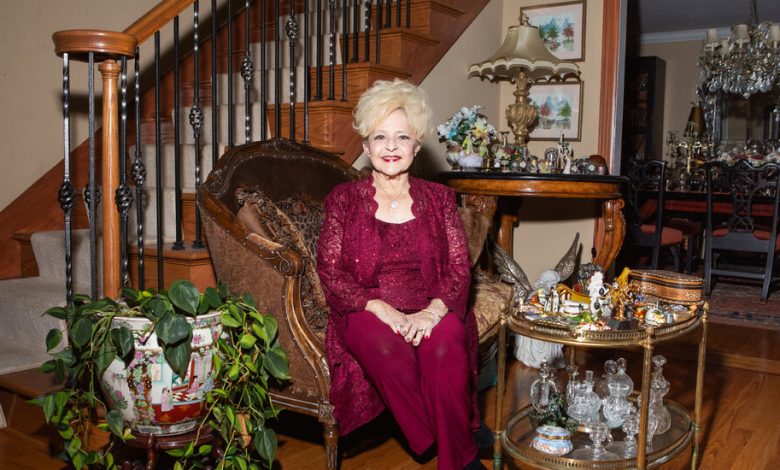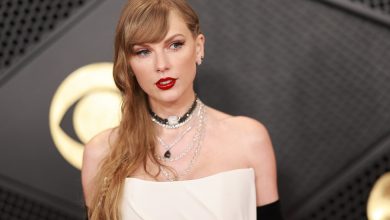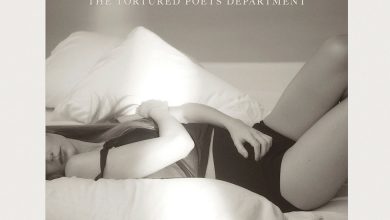Brenda Lee, a Queen of Christmas and So Much More

On a balmy day 65 years ago, a 13-year-old girl walked into a Nashville recording studio decorated with colored lights, garlands and a Christmas tree, the air conditioning cranked up to approximate a late-December chill. Members of the A Team, the session musicians who churned out hits for everyone in town, gamely donned Santa hats.
As she had many times before, the young singer laid down a raspy rockabilly vocal way beyond her years, then packed up and went home, hardly imagining that the result would outlive most of the people in the room.
“I would’ve never thought in my wildest dreams that ‘Rockin’ would be my signature song,” Brenda Lee said on a recent afternoon in her wood-paneled Nashville house, which is filled with gold and platinum record plaques and personalized memorabilia. To Lee, the song is just “Rockin’.” Always. Only a crimson pillow in her living room is embroidered with its full title: “Rockin’ Around the Christmas Tree.”
As if frozen at the precocious age when she became famous, Lee, now 78, still stands at a diminutive 4”9’ — maybe 4”11” with the hair — and wears a size 2½ shoe. (She shops in the children’s footwear section, or brings an empty suitcase to fill when she’s in Thailand, the only place she’s found adult shoes that fit.) Clad in a sequined red pantsuit, her petite frame immersed in an oversized leather chair, Lee sipped a Diet Coke (“I’m addicted”) and reminisced about her Christmas classic that even after her retirement, is still climbing the charts. “I think I’m making more now than I did when I was singing,” she said, and laughed.
Johnny Marks — who penned Christmas classics including “Rudolph the Red-Nosed Reindeer” and “Holly Jolly Christmas” — wrote “Rockin’ Around the Christmas Tree” with Lee in mind. She was a child prodigy whose explosive vocal talent had earned the nickname “Little Miss Dynamite.” When he sent her a demo, she was extra impressed because Marks was Jewish.
“I said, ‘Johnny! You don’t even believe in Christmas! How did you write this song?,’” she recounted. On a recent vacation, he explained, he’d been lying on a beach and was mesmerized by distant trees swaying in the ocean breeze. It almost seemed like they were … rocking. And unto us, a Christmas standard was born.
Not that it was an immediate success. “Rockin’” arrived in 1958, but failed to make waves. Then in 1960, after Lee had her first No. 1 hit with the wrenching ballad “I’m Sorry,” her label, Decca Records, attempted to capitalize on her newfound popularity and rerelease her Christmas tune. It worked: The song hit No. 14 that holiday season, and throughout the ’60s it continued to chart in December.
Prominent placement in the hit 1990 movie “Home Alone” introduced the song to a new generation. In more recent years, thanks to streaming, back-catalog Christmas music has become more lucrative than ever, and Lee’s tune — along with newer holiday standards like “Last Christmas” and “All I Want for Christmas Is You” — has made annual appearances on the Billboard Hot 100.
“She is living proof of how important you can be and how long you can last if you’re talented and you work hard and you truly love people,” the country singer Tanya Tucker said in an email. Lee inducted Tucker into the Country Music Hall of Fame in October, and people are still talking about the dry delivery and killer comic timing of her speech. Lee has, Tucker added, “the best sense of humor known to man (or woman).”
For the past four years, “Rockin’” has peaked at No. 2, but in honor of its 65th anniversary, Lee’s label is giving the song an extra push, including a new music video that features Lee lip-syncing to the tune she recorded as a teen, and even a TikTok account. Only one woman and her whistle register seem to stand in the way of this decades-old song hitting No. 1.
“Now I gotta worry about Mariah,” Lee said with a feisty laugh. “Get outta here, girl!” Growing more serious, she added, “Oh, there’s room for everybody. Her song’s good, too. I love her singing.”
Lee and Carey have never met, but they would certainly have a lot to talk about — like how it feels to have a groundbreaking, history-making career reduced in the popular imagination to a seasonal novelty. Because while Brenda Lee is a Christmas queen, she’s also so much more.
A LOT OF PEOPLE have stories. Brenda Lee has stories. She first met Elvis Presley in 1957 (“He was the pretty Elvis then”) when she was 12, the night she made her Grand Ole Opry debut; he was watching in the wings. “I’m never star-struck by anyone, and I’ve met the biggest,” she said. “But I was tongue-tied when I met him.”
Patsy Cline was her early tour mate and mentor (“a good old broad, in the nicest sense of the word”). While still in her teens, Lee shared bills with Little Richard, Chubby Checker, Dusty Springfield — the list is seemingly endless. In 1962, at the peak of her worldwide popularity, while in Hamburg on tour, the Beatles opened for her. “They were raw musically,” she said, “but they were fabulous.” The admiration was mutual: Years later, in a Rolling Stone interview, John Lennon declared that Lee “has the greatest rock ’n’ roll voice of them all.”
She’s still not quite sure where that voice came from. “I ask myself that sometimes,” she mused. “It’s just how I sing.” Raised poor (“you spell that ‘p-o-o-o-o-r,’ with four o’s,” she wrote in her 2002 autobiography) in the red clay of east Georgia, Brenda Mae Tarpley was born on Dec. 11, 1944. By age 3 she was standing on the counter at the general store, singing for change, and by 7 performing Hank Williams tunes on Atlanta TV.
She was a preternaturally quick study, picking up the hiccuping vocal style she heard Williams use on the radio as well as the growl of a bluesman who played around town, blending them into a unique style made even more remarkable by the fact it was coming out of the mouth of a girl who looked and dressed like Shirley Temple. Lee got her national break at 11, performing “Jambalaya” on the popular “Ozark Jubilee”; a recording contract with Decca soon followed. Her debut single billed her as “Little Brenda Lee (9 years old).” “Apparently,” Lee wrote, “being 11 wasn’t dramatic enough.”
By then, though, Lee was already the family’s sole breadwinner. When she was 8, her construction-worker father died after a hammer dropped on his head. To support her mother and two siblings, she developed a tireless work ethic, booking countless studio sessions and touring relentlessly. “We went by car and I slept up in the back window, that’s how little I was,” she said. “I just loved it so much that I didn’t mind the hardship. And I was young.”
Lee’s voice was nimble: She could excite teenagers with rockabilly hits like “Sweet Nothin’s” — Presley’s favorite Lee song, which was many years later sampled by Kanye West — and win over their parents by crooning ballads like “Emotions.” Her ability to straddle the worlds of pop, rock and country made her a constant fixture on the hit parade. Lee had the fourth most chart hits in the 1960s (47), surpassed only by Elvis, the Beatles and Ray Charles. She was the first woman to be inducted into both the Country Music Hall of Fame and the Rock & Roll Hall of Fame.
Lee was also one of the first American pop stars to find an international audience. At the time, she said, most artists didn’t want to give up domestic tour dates. Lee realized how shortsighted that approach was the first time she went to Japan and was greeted by a crowd holding “BLFC” signs: “Brenda Lee Fan Club.” She returned 31 more times. “They love you if you’ll come,” she said, sitting beside a sepia-toned globe several times larger than her head. “All they ask is that you come, and I loved to go.”
Lee’s house is cluttered with souvenirs from her travels and mementos from her peers. A sketch by Elton John sits on the piano, alongside a close-up photograph of Keith Richards’s hand, skull rings and all (“because it’s so distinct,” Lee said, adding, “He loves me. He’s a fun guy, too.”). Cyndi Lauper — an acolyte Lee particularly admires — once visited and left her lipstick in the bathroom. “And I’ve still got it,” Lee said, and giggled mischievously. “I’m Hector the Collector. Like the Shel Silverstein book. That’s just me.”
IN 1961, LEE booked a three-week stint headlining Las Vegas’s Sahara Hotel. The previous headliner had been her idol, Judy Garland, and when Lee arrived, she approached Garland as she was lounging by the pool. Lee still remembers the encounter vividly: “I said, ‘Miss Garland?’ And she looked up and I said, ‘Uh, my name is Brenda Lee and I’m an artist and I love you.’” Lee asked Garland if she had any showbiz advice. “She took those sunglasses off and she looked at me and she never faltered. And she said, ‘Don’t let anyone take your childhood.’”
Lee credits the support of those around her for helping her avoid the tragic fate of so many child stars. “I had people that cared about me,” she said, like her longtime manager Dub Allbritten. “He respected my wishes.” She continued to attend high school in Nashville when she could, and if something came up on her social calendar — “so-and-so’s graduation party” — Allbritten would let her prioritize that over the road. That autonomy was important to her. “I didn’t do that very often,” Lee said. “But I knew I could.”
And then there’s Ronnie Shackett, the impossibly tall guy she once spied across the aisle at a Jackie Wilson concert. Lee passed him a note: “Hi, my name’s Brenda, here’s my number. But I’m going to be gone for three months in Europe, working.” When she got back, he called. “Sometimes it works,” she said. They married in 1963.
Midway through our conversation, Shackett walked through the living room. “Fifty-seven years,” Lee marveled.
“It’s more than that, Brenda,” Shackett said. “We had a daughter in ’64.”
“I guess it is more than that,” Lee said. She paused for a moment to do the math and then clapped her hands in delight. “Sixty years! Lord. And he’s a good man. I lucked out.”
When Lee thinks back on her days recording with Bradley and the A Team, she mourns a version of the industry that doesn’t exist anymore. “I miss all of them that are gone tremendously because they were my friends,” she said. She can’t believe what often passes for a session in the digital age. “It just seems like now, you don’t even see the musicians,” she said. “You go in and sing to a track. The musicians always gave me my energy.”
“There’s no standards being written today,” Lee added. “And that hurts me, ’cause I go back to the ’60s all the time and listen to those songs. They’re still played all the time, ’cause they were good. They were done with people that loved what they did.”
Still, she added, there’s plenty of talent in Nashville today — “it’s oozing” — and she’s just glad she doesn’t have to compete with it. Despite the renewed attention to “Rockin,’” Lee retired from singing publicly in 2020. “God has blessed me that I don’t miss it,” she said. “I love to sing, but I can get that out of my system right here. I can go in the shower and sing. Good acoustics.”
She admitted that there’s nothing like the thrill of singing before a crowd, trying to win over the skeptics. But she’s traded that in for something else. “I can finally put my kids and my grandkids and my friends first,” she said. “For once, I’m here to see them.”
After 65 years of traveling the world, Lee has earned her rest. That’s not to say she won’t break out into an impromptu tune now and then; she recently went viral for surprising passengers by singing “Rockin’” on a plane intercom. Just don’t expect to see her on the road. “If somebody said, ‘Brenda, we’re coming to get you in the bus,’” she said in no uncertain terms, “I’d say, ‘Oh, no you’re not.’”




